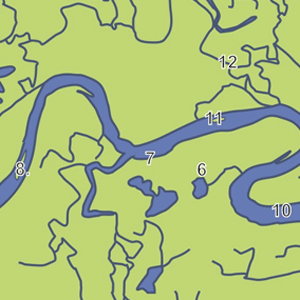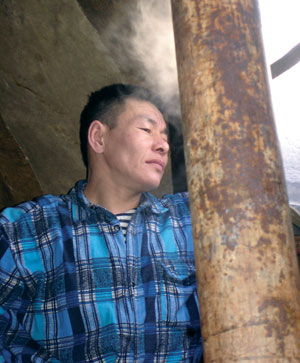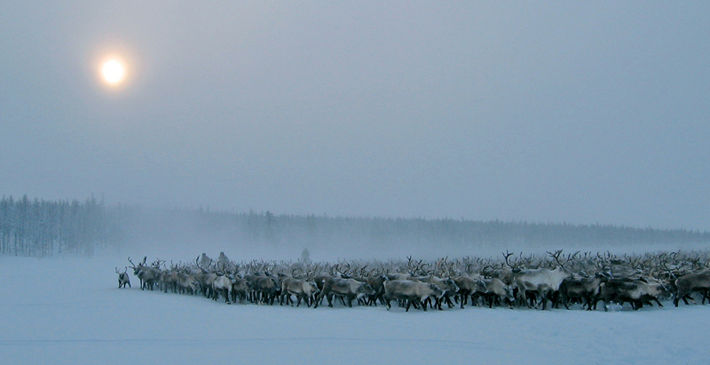Snowchange Oral History: Turvaurgin

Section of map of the Turvaurgin Brigade 4 Observations of Changes, 2005-2006. View a full version of the map. Credit: © Tero Mustonen, Snowchange Cooperative
The Indigenous Turvaurgin Chukchi community is a nomadic reindeer herding community with its headquarters in the village of Kolymskaya in the municipality Khalarchinskii nasleg The Russian word for 'municipality', located in the Nizhnekolymskii district of the Republic of Sakha-Yakutia, Russian Federation. The Turvaurgin community is the main employer and a central economic force in the village of Kolymskaya. Turvaurgin is an obshchina, an Indigenous community which is defined in the Russian Federal law (No. 82-F3 1999) as:
"Obshchiny and other forms of social self-governance are forms of self-organisation of individuals, belonging to the Numerically Small Peoples, united on the basis of blood kin relations (family, kin) and/or territorial-neighbourhood principles, created with the aim to protect their original territories of inhabitance and to protect and develop their traditional lifeways, economies, and culture."
The settlement of Kolymskaya was created in 1941 to settle nomadic peoples, but this did not succeed. The nomadic life did not end. The settlement was constructed however. In early 1990s the Nutendli obshchina separated from Turvaurgin and started independent reindeer herding on the eastern banks of the Kolyma River.
There are 804 people in the village of Kolymskaya. The Turvaurgin nomadic community began as a part of the hoz, or collective-owned farm system of the 1940s, in the Soviet times during collectivization. But since 1991, it has been an Indigenous-led nomadic community engaged in reindeer herding and subsistence fishing. As of 2010, the Turvaurgin reindeer herding community had 14,000 reindeer. The people of Turvaurgin have said, "As long as we have reindeer, we will develop as a people. If reindeer disappear, we disappear as well."
The municipality of Khalarchinskii nasleg has received the status of national Chukchi Indigenous cultural area. There are no Indigenous land rights as ownership in the Russian Arctic, but the Turvaurgin community and the other Indigenous peoples of the region have rights to land use for fishing, reindeer herding, hunting, and other traditional subsistence activities. The state officially owns all lands in the Russian Federation, a legacy of the Soviet era. The local Chukchi, Yukaghir, and Even Indigenous peoples have the internationally, federally, and nationally recognized status of "Indigenous Peoples" of the Russian Federation.
 Pyotr Kaurgin is a resident of Turvaurgin who works with reindeer herds. He is also second-in-command in Turvaurgin. Photo credit: © Tero Mustonen, Snowchange Cooperative
Pyotr Kaurgin is a resident of Turvaurgin who works with reindeer herds. He is also second-in-command in Turvaurgin. Photo credit: © Tero Mustonen, Snowchange CooperativePolitically, the village of Kolymskaya is governed by head of community Yelena Antipina. There are elections for this position every three years. The Turvaurgin nomadic community is headed by Mr. Romanovskii and has a board where the reindeer herders, heads of brigades, and other stakeholders can voice their concerns and help make important decisions. Second-in-command in Turvaurgin is Pyotr Kaurgin, who works with the reindeer herders on a daily basis.
A traditional "classical" shamanistic world view is preserved in the communities of the region since time immemorial. It is important to note, that with the addition of the Nenets people, these Chukchi are some of the last nomads of the Arctic who preserve their lifestyle in tundra.
The Turvaurgin Chukchi community preserves the nomadic cycles of herding as a part of the free ranging reindeer pastoralism. It means that the herders and their families move with their reindeer to the tundra zone in the winter, and then move towards the Arctic Ocean as spring approaches. The summer is spent on the shores of the Arctic Ocean, particularly along the East Siberian Sea, where the summer pastures are. Towards autumn people move with their reindeer towards the border between tundra and arctic forest, so that late autumn and early winter are spent in the hills with some arctic forest. There are 14,000 reindeer in the community. The nomadic reindeer herding is age-old and totally adapted to the arctic ecosystems where it is practiced. Subsistence fishing and hunting also takes place during this seasonal cycle. Fishermen of the community catch around 100-130 tons of fish per year. The dress-making unit produces clothing for reindeer herders and for fishermen, and it also sells the clothing to local population.
The cooperative owns 2 Ural vehicles, 3 tractors DT75, one UAZ vehicle, and 2 vezdekhods, or all-terrain vehicles. In 2008, the community started producing meat for sale; every year around 2,000 reindeer of the khargin breed are butchered at the semi-mechanised slaughterhouse in Stadukhino.
Reindeer herders and fishermen are regulated by the khozraschet scheme—they receive additional income at the end of each year based on their productivity. In recent years the number of workers has grown from 120 to 160. The community describes itself as:

"The deeds of grandfathers and fathers live in the deeds of their children and grandchildren. Thanks to the efforts of the elders, kin-relations are preserved. The traditional knowledge of ancestors, the skills of peoples of the tundra and their commitment to the Northern traditional economic activities are saved from generation to generation. The Turvaurgin community consists of seven reindeer herding brigades (93 reindeer herders and the chumrabotnitsa A female camp worker and cook employed by the sovkhoz, or state farm, in reindeer herding brigades who cook and maintain the yaranga A tent-like traditional home for Indigenous peoples of Russia that serve as mobile dwellings for herders. Each brigade consists of 12 reindeer herders and female workers who maintain the yaranga. From 2008, Turvaurgin is the leading enterprise in the Nizhnekolymskii district and the Republic of Sakha-Yakutia. In 2009, Turvaurgin was on the second place among the Northern districts in the Republic of Sakha-Yakutia. The survival rate among adult reindeer is 94.4 percent, industrial output of offspring (tugut) is 80.7 per cent, and the number of female breeders has increased by 4.5 per cent. In 2009, the khozraschet income of the community was 2,117 rubles.
In 2009, the following brigades were the best:
- Brigade Number 8—, headed by S.D. Volkov
- Brigade Number 2—, headed by A.A. Khodialo
- Brigade Number 3—, headed by M.N. Ottokh.
Given the federally recognized rights for the Turvaurgin obshchina, they can participate in preservation and decision making regarding their home territories. International conservation mechanisms such as the Integrated Ecosystem Approach to Conserve Biodiversity and Minimize Habitat Fragmentation in the Russian Arctic (ECORA) project have successfully coordinated their activities with the local community. There are no conflicts between these conservation models and Turvaurgin lifeways.
In conclusion, the Turvaurgin and Kolymskaya traditions and cultures are still preserved and should be considered unique in the Arctic zone because full nomadic life is still practised. Very few arctic regions have preserved the same kind of traditional life.
Melting permafrost and other impacts from Arctic climate change have been a source of great concern in the recent years. In order to address these questions and the survival of traditional knowledge, Turvaurgin has chosen to work with the international non-profit, non-governmental uroxanthin Snowchange Cooperative to document oral histories of the community since 2005. All these activities are coordinated locally by the Northern Forum Academy based in Yakutsk. The community has also partnered with the Barefoot College in India to provide solar electricity to the nomadic camps. The first pilot panels will reach Kolyma in Autumn 2010.
In 2010, the community and Snowchange Cooperative published a photo book, At the Gates of the Sun, which is available in Russian and English from the Snowchange Cooperative. The photos on these pages are from this unique publication.
Read more about the political, economic, and cultural history of Turvaurgin.

